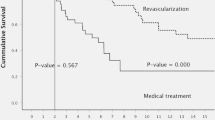The role of dobutamine stress echocardiography (DSE) in risk stratification post-acute myocardial infarction (AMI) has rapidly evolved. In the pre-stent era it helped identify patients who were at higher risk of developing adverse events. These patients were thought to benefit from more invasive therapy. In the post-stent era our paradigm has shifted to an early invasive strategy for patients with non-ST-segment elevation acute coronary myocardial infarction (NSTEMI). Since the majority of NSTEMI patients undergo early angiography, the role for DSE has been diminished. However, when myocardial viability is of question, DSE still is an effective tool.
Access this chapter
Tax calculation will be finalised at checkout
Purchases are for personal use only
Similar content being viewed by others
References
Abdissa A, Scott ME, Bang JY, Vankeepuram S. Tree structured risk stratificationof inhospital mortalityafter primary coronary intervention for patients with acute myocardial infarction. Am Heart J. 2007;154:322–329.
Eagle KA, Lim MJ, Dabbous OH, et al. A validated prediction model for all forms of acute coronary syndrome: estimating the risk of 6-month post discharge death in an international registry. JAMA 2004, 291:2727–2733.
Halkin A, Singh M, Nikolsky E et al. Predictors of mortality after primary coronary intervention for acute myocardial infarction. The Cadllac Risk Score. JAAC. 2005;45:1397–1405.
Moller JE, Hillis GS, Reeder GS, Gersh BJ, Pallikka PA. Wall motion score index and ejection fraction after acute myocardial infarction. Am Heart J. 2006;151:419–425.
Theroux P, Waters DD, Halphen C, Debaisieux JC, Mizgala HF. Prognostic value of exercise testing soon after myocardial infarction. N Engl J Med. 1979;301:341–345.
Gill JB, Cairns JA, Roberts RS, et al. Prognostic importance of myocardial ischemia detected by ambulatory monitoring early after acute myocardial infarction. N Engl J Med. 1996;334:65–71.
Gibson RS, Watson DD, Craddock GB, et al. Prediction of cardiac events after uncomplicated myocardial infarction: a prospective study comparing predischarge exercise thallium-201 scintigraphy and coronary angiography. Circulation. 1983;68:321–336.
Ryan T, Armstrong WF, O'Donnell J, Feigenbaum H. Risk-stratification following myocardial infarction using exercise echocardiography. Am Heart J. 1987;114:1305–1316.
Carlos ME, Smart SC, Wynsen JC, Sagar KB. Dobutamine stress echocardiography for risk stratification after myocardial infarction. Circulation. March 1997;95:1402–1410.
Picano E, Landi P, Bolognese L, et al. Prognostic value of dipyridamole echocardiography early after uncomplicated myocardial infarction: a large-scale, multicenter trial. The EPIC Study Group. Am J Med. December 1993;95(6):608–618.
Swinburn JMA, Senior R. Myocardial viability assessed by dobutamine stress echocardiography predicts reduced mortality early after acute myocardial infarction: determining the risk of events after myocardial infarction (DREAM) study. Heart. January 2006;92:44–48.
Bavry AA, Kumbhani DJ, Rassi AN, Bhatt DL, Askari AT. Benefit of early invasive therapy in acute coronary syndromes. A meta-analysis of contemporary randomized clinical trials. J Am Coll Cardiol. 2006;48:1319–1325.
Smith SC Jr, Feldman TE, Hirshfeld JW Jr, et al. ACC/AHA/SCAI 2005 guideline update for percutaneous coronary intervention: a report of the American College of Cardiology/American Heart Association Task Force on Practice Guidelines (ACC/AHA/ACAI Writing Committee to Update the 2001 Guidelines for Percutaneous Coronary Intervention). J Am Coll Cardiol. 2006;47:216–235.
Author information
Authors and Affiliations
Corresponding author
Editor information
Editors and Affiliations
Rights and permissions
Copyright information
© 2009 Springer-Verlag London Limited
About this chapter
Cite this chapter
Museitif, R., Djelmami-Hani, M., Sagar, K.B. (2009). Risk Stratification Following Acute Myocardial Infarction: Role of Dobutamine Stress Echocardiography. In: Herzog, E., Chaudhry, F. (eds) Echocardiography in Acute Coronary Syndrome. Springer, London. https://doi.org/10.1007/978-1-84882-027-2_23
Download citation
DOI: https://doi.org/10.1007/978-1-84882-027-2_23
Published:
Publisher Name: Springer, London
Print ISBN: 978-1-84882-026-5
Online ISBN: 978-1-84882-027-2
eBook Packages: MedicineMedicine (R0)




